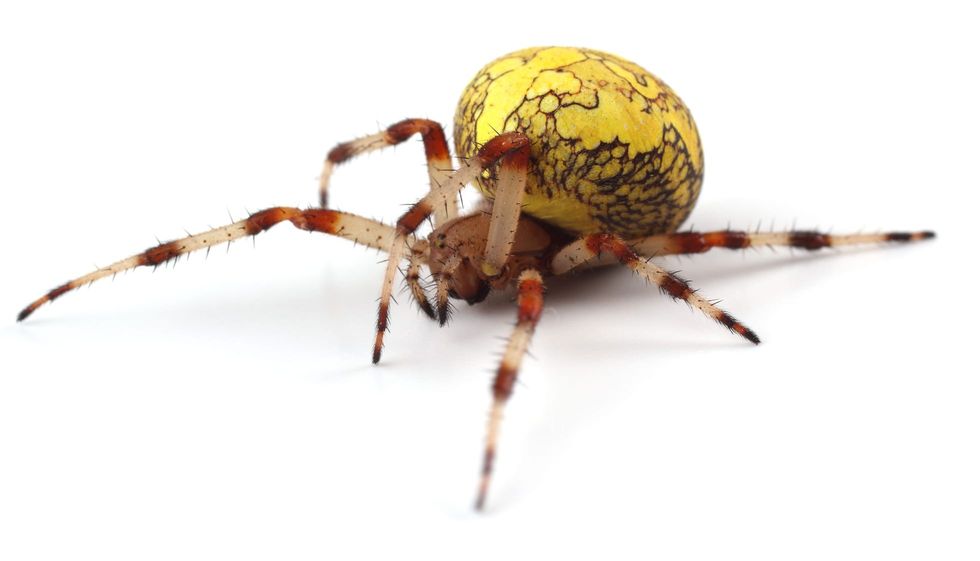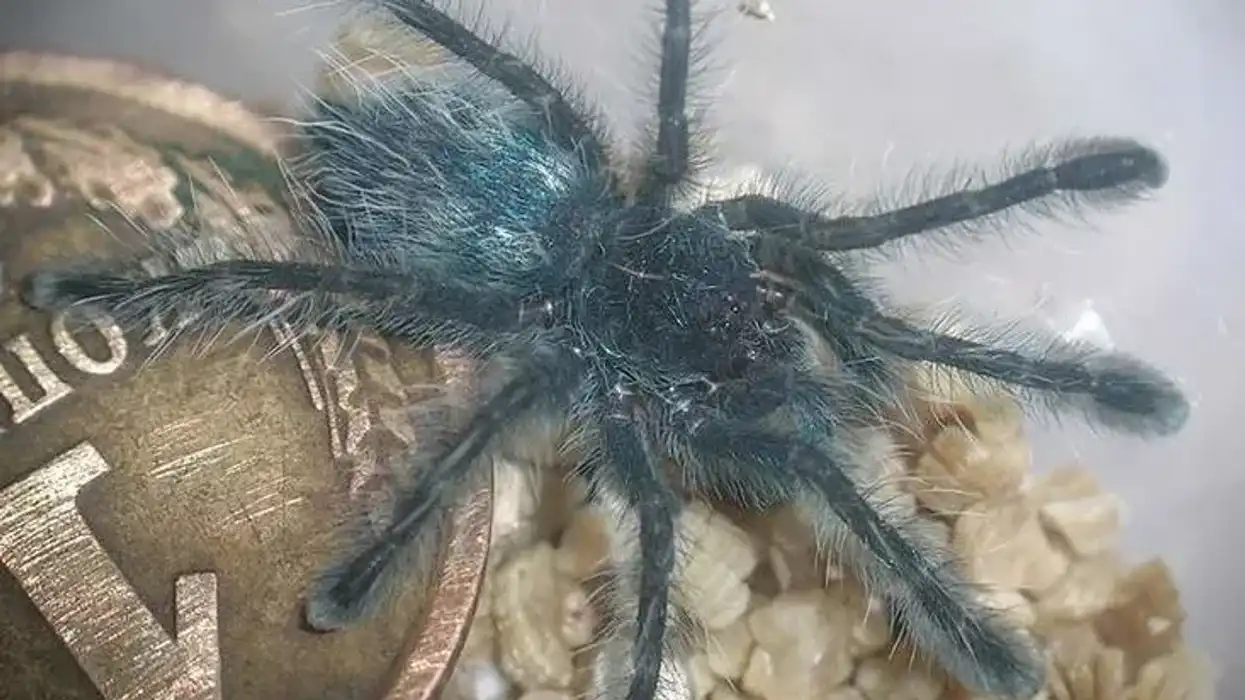Spiders may be scary but here we will introduce you to a beautiful-looking spider, who is rather very cute. The marbled orb-weaver (Araneus marmoreus) is a kind of spider that is famous for its oval-shaped abdomen and beautiful patterns.
They have marble-like patterns of white, yellow, black, and orange. Their habitat includes fields, forests, shrubs, and suburban areas in North America, North Asia, and Europe.
These spiders hatch from their eggs in the spring and reach maturity in the summer. Hence, the mating season of the spiders also arrives in the summer.
They eat all kinds of insects, and they don't go foraging for them. They make traps for their prey and wait for them by hiding nearby.
The spiders breed in a large number and don't have any great threat, so there is an abundance of them. The little venom they have also doesn't hurt humans, so they don't possess any harm to us.
Read on to know more marbled orb-weaver spider facts, and if you like this article, then check out the spiny orb-weaver and the Brazilian wandering spider.
Marbled Orb-Weaver Interesting Facts
What type of animal is a marbled orb-weaver?
The marbled orb-weaver (Araneus marmoreus) is a kind of spider.
What class of animal does a marbled orb-weaver belong to?
The marbled orb-weaver (Araneus marmoreus) belongs to the class Arachnida of animals.
How many marbled orb-weavers are there in the world?
The exact population of these spiders is not known. Even though they have quite a few predators, the spiders still breed in large numbers and we can assume that their population is not currently threatened.
Where does a marbled orb-weaver live?
The marbled orb-weavers live through the Nearctic and Palearctic regions reaching the Holarctic region. They can be seen the United States, like in North Dakota, Texas, Alaska, throughout Canada, Europe, parts of North Asia, and Russia.
What is a marbled orb-weaver's habitat?
These spiders live in all kinds of habitats. They can be seen in agricultural fields, coniferous and deciduous forests, peat bogs, meadows, at the edges of forests, and many other places. They usually roam around shrub areas, trees, and mailboxes in suburban and rural areas.
Who do marbled orb-weavers live with?
The marbled orb-weaver is solitary in nature. They are usually active at night and live alone.
How long does a marbled orb-weaver live?
The spiders live for only about six months. The eggs hatch in the spring and by the next fall, they reach sexual maturity, so they mate and then die.
How do they reproduce?
The mating season for marbled orb-weavers comes in the summer. The exact reproductive behavior of the species has not been researched in a broader sense, but we can assume the nature of their reproduction from other spiders of the Araneus genus.
The adults of the female spiders of the genus release pheromone to attract mates. The adults of the male spiders spin a mating thread at the web of the female.
Then the male walks across that thread towards the female, and the female starts to advance toward the male.
The spiders of the genus show the nature of sexual cannibalism, but a male marbled orb-weaver is known to mate quite a few times in their lifetime, so it's very much possible that this species of spider doesn't show cannibalistic traits. The females make egg sacs with silk and lay their eggs in them.
There may be several hundred eggs in one egg sac. The eggs hatch from the egg sacs in the spring and go through many instars molting and growing until the summer when they become adults.
What is their conservation status?
The conservation status of the spiders is Not Listed under the International Union for Conservation of Nature. We can only assume that they are not endangered or the species is not in any way threatened currently.
Marbled Orb-Weaver Fun Facts
What do marbled orb-weavers look like?

These spiders are polymorphic and have oval-shaped abdomens. The females of the species are also larger than the males.
According to the colors and patterns on their abdomen, there are two forms present among the species of spiders - 'variation pyramidatus' and 'nominate marmoreus'. Both variations have white, yellow, and orange to the light brown abdomen with white, black, and grey patterns on them.
Their legs also have striped patterns of white, black, and clear colors. The only distinctive quality between the two variations is that the variation pyramidatus has a brown-colored mark at the end of their paler than usual abdomen.
How cute are they?
Marbled orb-weavers can look extremely beautiful and cute with the colorful marble pattern on their back. Some spiders may seem scary to a lot of people but these ones will surely get your attention with their beauty if you see them.
How do they communicate?
These spiders communicate visually, chemically, and through vibrations. The spiders have tactile hair on their body which can sense vibrations in their surroundings to help them figure out what is causing the vibration and from which direction it's coming.
Other species of the same genus release pheromones in order to find mates. We can surely assume that the female marbled orb-weaver spiders also do the same.
How big is a marbled orb-weaver?
The females of the species are larger than the males. The males grow up to be 0.2-0.3 in (5.1-7.6 mm) in length and females are about (7.6-18 mm) in length. They are more than six times smaller than the world's largest spider, the goliath birdeater, whose length is around 5.1 in (13 cm).
How fast can marbled orb-weavers move?
The exact speed of the marbled orb-weaver spider is not known. They move at a moderate pace compared to many other species of spiders.
How much does a marbled orb-weaver weigh?
These are small spiders. They only weigh about 0.02 oz (0.69 g).
What are their male and female names of the species?
There are no specific names for the males and females of the species.
What would you call a baby marbled orb-weaver?
A baby marbled orb-weaver is called a spiderling.
What do they eat?
Marbled orb-weavers eat all kinds of insects that are smaller than them, mainly from the Hymenoptera, Diptera, and Orthoptera orders. They have a distinctive way of catching prey.
They build their webs to catch their prey, then they attach a silk thread which is the signal thread from the side of the web to them. When prey gets stuck in the webs, the signal thread vibrates and lets the spider know.
Then the spider comes out of its hiding spot and attacks the prey. This method also helps the spider hide from predators.
Are they harmful?
These spiders have very little venom. It is not at all harmful to humans. The venom is only present to help with catching their prey and the digestive process of the spider. They are also not aggressive at all, so the chances of them biting a human are very small.
Would they make a good pet?
Marbled orb-weavers are wild spiders. They can still be kept as pets. They are low-maintenance animals, but they don't live for long. They can make good pets but it's advisable to leave them be to live their life.
Did You know...
The patterns on the abdomen of the marbled orb-weaver give them the look of marble. That's where they get their common names.
The Marbled Orb-Weaver's Bite
Marbled orb-weavers are not at all aggressive, so, they don't bite humans, and they also don't have that much venom to harm a human. The venom is only there to paralyze their prey.
Can you keep marbled orb-weavers as pets?
Even though some orb-weavers are kept as pets, marbled orb-weaver spiders are not ideal to be kept as pets. They look beautiful and you may want to keep them as pets, but you need to know that they don't look for food, they need to be given food, they are low maintenance, but don't live very long.
It's rather better that they are left to live their life in the wild.
Here at Kidadl, we have carefully created lots of interesting family-friendly animal facts for everyone to discover! Learn more about some other arthropods including the six-eyed sand spider and the orb-weaver spider.
You can even occupy yourself at home by drawing one of our Marbled orb-weaver coloring pages.










